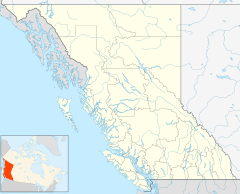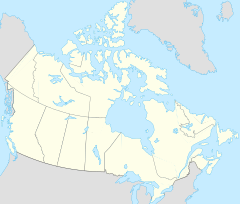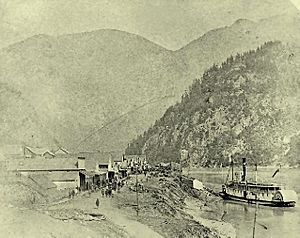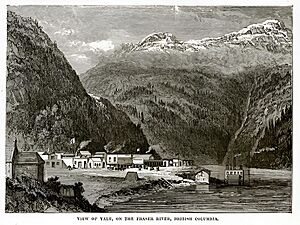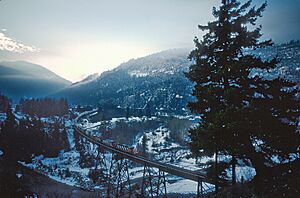Yale, British Columbia facts for kids
Quick facts for kids
Yale
|
|
|---|---|
|
Unincorporated community
|
|
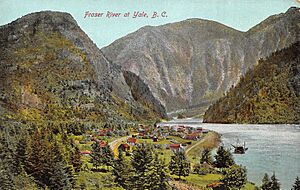
Postcard- Yale, BC, c.1910
|
|
| Country | Canada |
| Province | British Columbia |
| Region | Fraser Canyon |
| Regional District | Fraser Valley Regional District |
| Post office founded | N/A |
| Area
(2021)
|
|
| • Land | 3.38 km2 (1.31 sq mi) |
| Population
(2021)
|
|
| • Total | 162 |
| • Density | 47.9/km2 (124/sq mi) |
| Time zone | UTC−08:00 (PST) |
| • Summer (DST) | UTC−07:00 (PDT) |
Yale is a small, unincorporated community in the Canadian province of British Columbia. It became very important during the Fraser Canyon Gold Rush because of its location.
Yale sits right on the Fraser River. It is often seen as the place where the British Columbia Coast meets the Interior parts of British Columbia. Just north of Yale, the Fraser Canyon begins, and the river becomes too rough for most boats. Even though the Fraser River can be rough south of Yale, steamboats could reach Yale if the pilots were skilled and the water conditions were good.
During the gold rush, Yale was a very busy place. It had many docks, bars, restaurants, hotels, and other services. At its busiest, Yale's population was around 15,000 people. More often, it had between 5,000 and 8,000 residents.
Today, many people living in Yale are part of the self-governing Yale First Nation. There are also some local businesses like stores, restaurants, and motels. The town's only gas station closed recently, as did its general store. Yale is a popular starting point for Fraser River rafting trips, and some companies have campgrounds nearby. Not much of the old gold rush town remains, as the docks disappeared long ago. The railway, built in the 1880s, now runs where the main street used to be. The Yale Museum is on old Front Street, next to the railway tracks. Close by is the Anglican Church of St. John the Divine, which is one of the oldest churches in British Columbia.
Yale also has a unique natural setting. Each summer, a group performs a historical reenactment to celebrate the Royal Engineers. These engineers worked under Richard Clement Moody and helped build important roads like the Cariboo Wagon Road and the Douglas-Lillooet Trail. They were a big part of Yale's life from the gold rush until the late 1870s.
Contents
The History of Yale
How Yale Was Founded
Yale was founded in 1848 by the Hudson's Bay Company. It was first called Fort Yale. Ovid Allard, the manager of the new trading post, named it after his boss, James Murray Yale.
During the peak of the Fraser Canyon Gold Rush, Yale was a very famous place. Some people even said it was the largest city west of Chicago and north of San Francisco. It was also known as a wild and busy place.
Yale's Role in Early British Columbia
Yale played a key role in important events during the gold rush. These events, like the Fraser Canyon War and McGowan's War, made people worry that the United States might try to take control of the region.
During these times, important government leaders came to Yale. They included Governor James Douglas, judge Matthew Baillie Begbie, and military leaders like Chartres Brew and Richard Clement Moody. They came to talk with American miners and make sure British rule stayed strong.
Building the Cariboo Road
Because steamboats could reach Yale, it was chosen as the starting point for the Cariboo Wagon Road. This important road was built in the early 1860s. It connected Yale to Barkerville, passing through towns like Lytton, Ashcroft, and Quesnel.
By the 1870s, another road, the Yale Road, was built from New Westminster to Yale. This road is now known in parts as Old Yale Road. Another road, the Dewdney Trunk Road, was built on the north side of the river.
The Railway Era and Decline
Yale continued to do well for about 20 years after the gold rush because it was a key transfer point for the Cariboo Road. Even though its population went down, it kept some of its importance.
When the Canadian Pacific Railway was built in the 1880s, it went right through Yale. This construction changed the town's old business area and its connection to the riverfront.
Yale became the main office and home for Andrew Onderdonk, the American contractor building the railway. The town boomed again with more people and new businesses because of the railway work.
Once the railway was finished in 1885, daily train service to Vancouver began. This made Yale a popular place for day trips. However, after the railway construction ended, Yale's population dropped sharply by 1890 and continued to decline.
In 1886, Andrew Onderdonk gave his property to be used as a girls' school called All Hallows. This school was very well-known and operated for many decades, until the 1920s.
Modern Highways and Yale's Future
Building the railway damaged parts of the old Cariboo Wagon Road. A new highway north from Yale, the Cariboo Highway, was not built until 1922. This highway was later improved to become the Trans-Canada Highway. For a long time, this was the main route connecting the Interior Plateau to the Lower Mainland.
After major upgrades to the Cariboo Highway in the 1950s, Yale and other towns in the canyon saw another boom. However, when the faster Coquihalla Highway opened in the 1980s, traffic started to bypass Yale. This caused Yale's economy and population to decrease again.
Population Information
In 2021, the community of Yale had a population of 162 people. These people lived in 86 of the 118 homes available. This was a small increase from its 2016 population of 143 people.
Yale covers a land area of about 3.38 square kilometers. This means there were about 47.9 people living in each square kilometer in 2021.
The average age of people in Yale is 56.8 years old, with a median age of 62.4. This is older than the average age for all of British Columbia, which is 43.1 years. The main language spoken in Yale is English.
Yale on Television
Yale has been shown on the historical television series Gold Trails and Ghost Towns. It was featured in season 1, episode 7 of the show.


